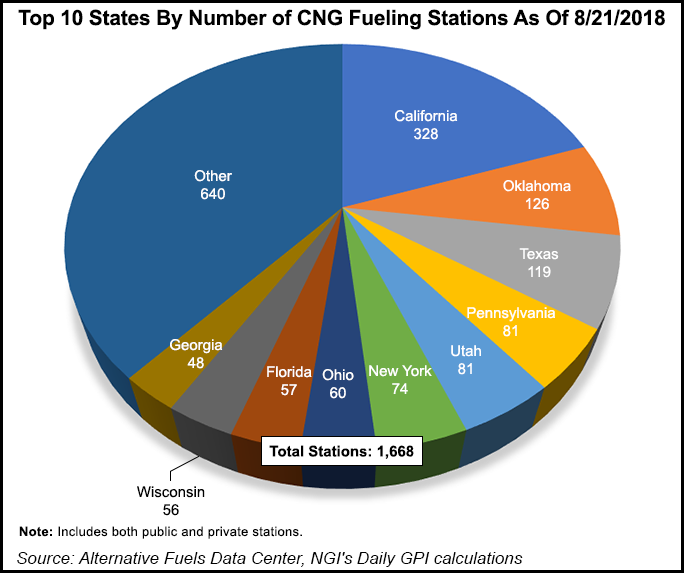Infrastructure | NGI All News Access
SoCalGas Helps Put More Ultra-Low Emission NGV Trucks on Road
Southern California Gas Co. (SoCalGas) and major fleet operator Food Express Inc. (FXI) are putting 11 new ultra-low emission natural gas vehicle (NGV) trucks on the road in FXI’s expanding natural gas-powered fleet.

SoCalGas assisted the fleet operator in obtaining $1.1 million in state grants for alternative fuel heavy duty fleet vehicles. FXI said the ultra-clean trucks began making deliveries Aug. 14. FXI has another 35 trucks on order.
Purchase of 46 new trucks represents about half of the FXI’s California fleet, and it said there is another $900,000 in potential grant money through California’s Proposition 1B, a ballot initiative in which voters established a funding program that is administered by regional air quality management districts.
Both the San Joaquin Valley and San Diego Air Pollution Control Districts are involved, along with the California Hybrid and Zero-Emission Truck and Bus Voucher Incentive Program. FXI is replacing 55 diesel trucks with new ultra-low emission natural gas trucks, which is the equivalent of taking more than 3,100 passenger cars off the road, said a SoCalGas spokesperson.
“Our fleet travels about 7.5 million miles in California each year, and the technological advancements of these new heavy-duty engines made our decision to switch to NGV trucks an easy choice,” said Kevin Keeney, vice president at Arcadia, CA-based Food Express.
SoCalGas’ Yuri Freedman, senior director for business development, said the Sempra Energy utility has assisted customers with more than 400 applications for incentive funding in California for fleet operators wanting to replace existing diesel trucks with NGVs. It comes at a time when California is experiencing an increase in greenhouse gas (GHG) emissions in the transportation sector, which accounts for 41% of the state’s GHG emissions.
Aside from the transportation sector, in the Bakken Shale oilfields in North Dakota there is some budding demand for the use of both compressed natural gas (CNG) and liquefied natural gas (LNG) as a means of reducing the volumes of flared gas from the state’s robust oil output. With a tightening of midstream gathering and processing capacity operators are having difficulty meeting statewide gas capture goals.
“Operators are watching their gas production on a daily basis and making choices to avoid [state] Industrial Commission-imposed production restrictions,” said Lynn Helms, director of the North Dakota Department of Mineral Resources during a recent webinar.
“There are two ways to move gas from a wellsite if there is no pipeline option — one is to liquefy it and the other is to compress it at high pressures, such as 25,000 psi, and move it in containers,” said Helms. “Either way, you take something that would have been flared and you use it to replace diesel fuel in running the rigs.
“We think the use of CNG and LNG at the wellsite is something we should be incentivizing, and that is why we built it into the [state] gas capture policy.”
In the ongoing ethanol debate, pro and anti-ethanol forces are preparing for a push from the Trump administration to provide $12 billion in subsidies to farmers to offset financial losses they are facing tied to President Trump’s tariff war.
On a recent political trip to Iowa, Trump said his administration is moving closer to eliminating the 12-month waiver on E15, allowing year-round sales of gasoline with the E15 form of ethanol. Historically, it has been prohibited during summer months because of smog concerns.
In more recent years federal environmental authorities have worked to keep the proportion of ethanol to gasoline in U.S. supplies at 10%. Generally, the auto and boating industries alike have resisted the use of ethanol, but the Trump administration may be poised to reverse that, according to a commentary on the Institute for Policy Innovation blog by Merrill Mathews, who equates the administration’s interest to providing pork barrel offsets to Iowa farmers.
Officials at the Advanced Clean Transportation (ACT) Expo have projected that California may pass a long-forgotten zero emission vehicle (ZEV) goal with close to 10% of auto sales in the state being ZEVs at the end of 2018. ACT noted that California has had ZEV standards for auto manufacturing and sales for 28 years.
At one time, the California Air Resources Board (CARB) established a goal of 7% of the state’s new car sales being ZEVs by 1997, but the goal has never been met. ZEV sales in the state last year reached 5.3%. Nevertheless, “2018 might be the year where California meets the 1997 ZEV sales targets as projections show that 9.5% of total auto sales could be ZEVs by the end of this year,” ACT noted in its newsletter.
“The historical pace of ZEV adoption is critical to forecasting the future, helps us understand why GHG emissions in the transportation sector are increasing, and informs the challenges facing the state as attention is shifted to achieve California’s SB 32 GHG emission targets,” according to the newsletter.
© 2024 Natural Gas Intelligence. All rights reserved.
ISSN © 1532-1231 | ISSN © 2577-9877 |
